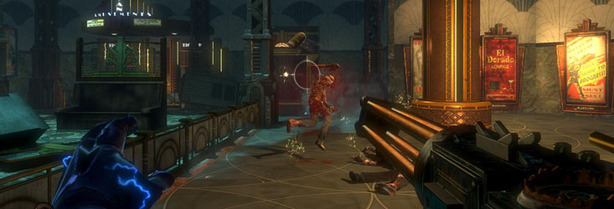
Hacking / Plumbing
There’s a long way to say this and there’s a short way to say this and, on a related note, I’m not paid by the word but I do have to at least fill up the rest of this page.The core gameplay of BioShock 2 is mostly unchanged from the previous game. There, I said it. The engine, the running, gunning and dual-use of plasmids and weapons – all that stuff is exactly the same as it was in the previous game, right down to similarities in the tutorial sequence and the order and pacing of the first few missions.
There are differences too, obviously. The fact that you’re a Big Daddy and not just some puny meatbag now means that your weapons all look a bit more powerful and intimidating, for example. The equivalent of the wrench from the first game is the Big Daddy’s drill-arm, which can bore holes in enemies faster than an army of woodworm eating through Pinnochio’s heart. Likewise, BioShock’s pistol has been replaced by a heavy duty rivet gun, while the puny Tommy Gun is now a quad-barrelled minigun.
When it comes to weapons though it’s hard to get away from the fact that everything feels underpowered and lack-lustre, as if the changes are aesthetic only and the underlying damage values, recoil, etc. are unchanged. You’d think that a creature the size of a Big Daddy would be able to knock limbs asunder by charging in with a motorised drill for a weapon, but even early enemies take multiple bashes to go down. The rivet gun too just doesn’t feel like it has the required punch to meld plywood together, let alone fire pelts of metal at speeds that might injure. The minigun too feels noticeably mini.
One area where BioShock 2 has begun to excel though is in capturing the fragility that you’d expect a non-functioning underwater city to have; everything feels messy and the city has been picked clean until even the skeleton has gouges in it. Scavengers have been living here for more than a decade now and that’s a vibe you can pick up on from the moment you start playing.
Early in the game especially critical supplies can be hard to come by unless you want to switch from Big Daddy to Big Hobo and search through every bin you find. 2K has managed to perfectly balance the idea that, although there are resources everywhere, Rapture is running on fumes at this point. Players who charge on recklessly and don’t bother to check side corridors will find themselves low on ammo very quickly and reliant on their wits more than ever.
More likely, they’ll end up dead because BioShock 2 doesn’t mess around when it comes to accelerating the challenge. Automated turrets and slyly hidden cameras were only gradually introduced in the first game, but here they make early appearances alongside regular arena fights and battles with the Big Sister.
As far as BioShock 2 is concerned though, death is only a choice and the controversial (and arguably game-breaking) Vita-Chambers return for you to make use of – but only if you want to. You can utterly disable Vita-Chambers from the options menu if you want, but by default you’ll respawn inside one whenever you die with half-health and half-EVE. It’s undeniably handy for new players who find the Big Sister battles a bit tough, but be warned that it can also reduce the game to little more than a grind as you whittle through enemies by virtue of incredible patience.
At the end of the day, Vita-Chambers are a matter of personal preference. BioShock 2’s combat feels, just like the previous game’s, a bit clumsy at times and the ability to use Vita-Chambers means that the game isn’t always punishing you with lost progress just because you had the wrong ammo loaded in your gun when you turned a corner. On the other hand, it does mean that one side of the risk/reward equation is utterly absent.
We could argue the matter all day if needed – and probably will on the next bit-tech podcast – but right now we’ll move on to the multiplayer side of the game instead.

MSI MPG Velox 100R Chassis Review
October 14 2021 | 15:04











Want to comment? Please log in.